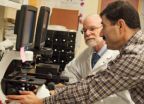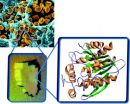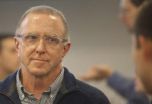(Press-News.org) Small non-coding RNAs can be used to predict if individuals have breast cancer conclude researchers who contribute to The Cancer Genome Atlas project. The results, which are published in EMBO reports, indicate that differences in the levels of specific types of non-coding RNAs can be used to distinguish between cancerous and non-cancerous tissues. These RNAs can also be used to classify cancer patients into subgroups of individuals that have different survival outcomes.
Small non-coding RNAs are RNA molecules that do not give rise to proteins but which may have other important functions in the cell. "For many years, small non-coding RNAs near transcriptional start sites have been regarded as 'transcriptional noise' due to their apparent chaotic distribution and an inability to correlate these molecules with known functions or disease," explains Steven Jones, one of the lead authors of the study, a professor at Simon Fraser University and the University of British Columbia, and a distinguished scientist at the BC Cancer Agency. "By using a computational approach to analyze small RNA sequence information that we generated as part of The Cancer Genome Atlas project, we have been able to filter through this noise to find clinically useful information," adds Jones. "The data from our experiments show that genome-wide changes in the expression levels of small non-coding RNAs in the first exons of protein-coding genes are associated with breast cancer."
The scientists were able to distinguish between the many different small non-coding RNAs that are found near the transcriptional start sites of genes in healthy individuals and patients with breast cancer (in this case, breast invasive carcinoma). They mapped these RNA molecules to specific locations on the DNA sequence and looked for correlations between the non-coding RNAs that were strongly expressed and the disease status of the patients from whom the tissue samples were isolated. The researchers then tested if the expression of the small RNAs in genomic locations that they were able to identify could be used to predict the presence of disease in another group of tissue samples obtained from patients known to have breast cancer. The test efficiently predicted the correct disease status for the samples in the new study group.
"The potential to predict cancer status is restricted to only a subset of the many small non-coding RNAs found near transcription start sites of the genes. What's more, these RNA locations are highly enriched with CpG islands," says Athanasios Zovoilis, the first author of the study. CpG islands are genomic regions that contain a high frequency of cytosine and guanine. The presence of these RNAs in these islands may implicate their involvement with DNA methylation processes and the onset of disease but additional experiments are needed to explore and prove this link.
"This is the first time that small non-coding RNAs near the transcription start site of genes have been associated with disease," says Jones. "Further work is required but based on our data we believe there is considerable diagnostic potential for these small non-coding RNAs as a predictive tool for cancer. In addition, they may help us understand better the mechanisms underlying oncogenesis at the epigenetic level and lead to potential new drugs employing small non-coding RNAs." The researchers also note that this class of small non-coding RNAs may be useful in predicting the existence of other types of cancer or disease.
The generation of data by The Cancer Genome Atlas project, which now provides access to large amounts of sequencing information for diseased and normal tissues, made the work possible. The Cancer Genome Atlas is now one of the largest resources for small non-coding RNAs in existence.
INFORMATION:
The expression level of small non-coding RNAs derived from the first exon of protein coding genes is predictive of cancer status
Athanasios Zovoilis, Andrew J Mungall, Richard Moore, Richard Varhol,
Andy Chu, Tina Wong, Marco Marra, Steven JM Jones
Read the paper:
doi: 10.1002/embr.201337950
The paper will be available online from 14:00 Central European Time on 17 February. Alternatively send an e-mail to barry.whyte@embo.org
Further information on EMBO reports is available at embor.embopress.org
Media Contacts
Barry Whyte
Head | Public Relations and Communications
barry.whyte@embo.org
Nonia Pariente
Senior Editor, EMBO reports
Tel: +49 6221 8891 305
pariente@embo.org
About EMBO
EMBO is an organization of more than 1500 leading researchers that promotes excellence in the life sciences. The major goals of the organization are to support talented researchers at all stages of their careers, stimulate the exchange of scientific information, and help build a European research environment where scientists can achieve their best work.
EMBO helps young scientists to advance their research, promote their international reputations and ensure their mobility. Courses, workshops, conferences and scientific journals disseminate the latest research and offer training in techniques to maintain high standards of excellence in research practice. EMBO helps to shape science and research policy by seeking input and feedback from our community and by following closely the trends in science in Europe.
For more information: http://www.embo.org
Small non-coding RNAs could be warning signs of cancer
2014-02-17
ELSE PRESS RELEASES FROM THIS DATE:
New finding points to potential options for attacking stem cells in triple-negative breast cancer
2014-02-17
ANN ARBOR, Mich. — New research from the University of Michigan Comprehensive Cancer Center and Georgia Regents University finds that a protein that fuels an inflammatory pathway does not turn off in breast cancer, resulting in an increase in cancer stem cells. This provides a potential target for treating triple negative breast cancer, the most aggressive form of the disease.
The researchers identified a protein, SOCS3, that is highly expressed in normal cells but undetectable in triple-negative breast cancer. They showed that this protein is degraded in cancers, blocking ...
Religious and scientific communities may be less combative than commonly portrayed
2014-02-17
One of the largest surveys of American views on religion and science suggests that the religious and scientific communities may be less combative than is commonly portrayed in the media and in politics.
Only 27 percent of those surveyed said that they viewed science and religion as being in conflict with each other, with about equal percentages of those people "siding with either religion or science," said Rice University sociologist Elaine Howard Ecklund at the AAAS Annual Meeting. The survey was commissioned by the AAAS Dialogue on Science, Ethics and Religion (DoSER) ...
Uncovering the secrets of tularemia, the 'rabbit fever'
2014-02-17
WASHINGTON D.C. Feb. 16, 2014 -- Tularemia, aka "rabbit fever," is endemic in the northeastern United States, and is considered to be a significant risk to biosecurity -- much like anthrax or smallpox -- because it has already been weaponized in various regions of the world.
At the 58th Annual Biophysical Society Meeting, which takes place Feb. 15-19, 2014, in San Francisco, Calif., Geoffrey K. Feld, a Postdoctoral researcher in the Physical & Life Sciences Directorate at Lawrence Livermore National Laboratory (LLNL), will describe his work to uncover the secrets of the ...
Bacterial superbug protein structure solved
2014-02-17
WASHINGTON D.C. Feb. 16, 2014 -- A research team from Vanderbilt University Medical Center in Nashville, Tenn., is the first to decipher the 3-D structure of a protein that confers antibiotic resistance from one of the most worrisome disease agents: a strain of bacteria called methicillin-resistant Staphylococcus aureus (MRSA), which can cause skin and other infections. The Vanderbilt team's findings may be an important step in combatting the MRSA public health threat over the next 5 to 10 years.
By deciphering the shape of a key S. aureus protein -- an enzyme called ...
Harvesting light, the single-molecule way
2014-02-17
WASHINGTON D.C. Feb. 16, 2014 -- New insights into one of the molecular mechanisms behind light harvesting, the process that enables photosynthetic organisms to thrive, even as weather conditions change from full sunlight to deep cloud cover, will be presented at the 58th Annual Biophysical Society Meeting, taking place in San Francisco from Feb. 15-19.
At the meeting, Hsiang-Yu Yang, a graduate student, and Gabriela Schlau-Cohen, a postdoc in W.E. Moerner's research group at Stanford University, will describe how probing these natural systems at the single molecule level ...
Deep ocean needs policy, stewardship where it never existed
2014-02-17
BEAUFORT, N.C. -- Technological advances have made the extraction of deep sea mineral and precious metal deposits feasible, and the dwindling supply of land-based materials creates compelling economic incentives for deep sea industrialization. But at what cost?
“We’re really in the dark when it comes to the ecology of the deep sea," said Linwood Pendleton, director of the Ocean and Coastal Policy Program at the Nicholas Institute for Environmental Policy Solutions at Duke University. "We know a lot about a few places, but nobody is dealing with the deep sea as a whole, ...
Obesity in Samoa: A global harbinger?
2014-02-17
PROVIDENCE, R.I. [Brown University] — The South Pacific archipelago of Samoa and American Samoa harbors a global health mystery that may seem both remote and extreme but could foretell trends in obesity and related conditions across much of the developing world.
About three-quarters of the U.S. territory's adult population is obese, the highest rate in the world with independent Samoa quickly catching up. Rates of type 2 diabetes top one in five and a recent study found that the elevated obesity rates are present even in newborns.
This pandemic began only a few decades ...
Global perspectives on human biology and health
2014-02-17
CHICAGO --- Three anthropology professors from the Weinberg College of Arts and Sciences at Northwestern University will highlight recent research in biological anthropology Sunday, Feb. 16 at the annual meeting of the American Association for the Advancement of Science (AAAS) in Chicago.
The presentations, part of the symposium "Comparative Advantage: Global Perspectives on Human Biology and Health" will be held from 1:30 to 4:30 p.m. in Crystal Ballroom A at the Hyatt Regency Chicago.
Christopher Kuzawa, professor of anthropology and faculty fellow at the Institute ...
Nanoelectronics key to advances in renewable energy
2014-02-17
TEMPE, Ariz. – Nanoscale technology looks promising as a major contributor to advancements needed to fulfill the potential of emerging sources of clean, renewable energy.
Progress in the comparatively new area of nanoelectronics in particular could be the basis for new manufacturing processes and devices to make renewable energy systems and technologies more efficient and cost-effective.
Stephen Goodnick will focus on what nanoelectronics advances could do to help push the performance of solar energy systems to the next level in his talk at the 2014 annual meeting of ...
Epigenetic regulation required to ensure correct number of chromosomes
2014-02-17
Abnormal number of chromosomes is often associated with cancer development. In a new study published in the journal Nature Structural and Molecular Biology researchers at Karolinska Institutet in Sweden have shown that a subtle epigenetic change plays an important role in the correct segregation of chromosomes.
Normally when a cell divides, the chromosomes are segregated equally to two daughter cells. However, tumour cells frequently have either too few or too many chromosomes, leading to the incorrect expression of a number of genes. When a cell is about to divide, the ...




